Preparation and Characterization of New Environmentally Friendly Starch-Cellulose Materials Modified with Casein or Gelatin for Agricultural Applications
Abstract
1. Introduction
2. Materials and Methods
2.1. Materials
2.2. Preparation of Starch Films and Cellulose-Starch Composites
2.3. Properties of Starch Film and Cellulose-Starch Composites
2.3.1. Mechanical Properties
2.3.2. Equilibrium Swelling
2.3.3. Thermo-Oxidative Aging Resistance
2.3.4. Fourier Transformation Infrared Spectrometer and Microscopic Analysis
2.3.5. Color Characteristics
2.3.6. Soil Tests
2.3.7. Study of Susceptibility to Biodegradation of Starch Films and Cellulose-Starch Composites
2.3.8. Optical and SEM Microscopic Analysis
2.3.9. Thermal Analysis
2.3.10. Sowing Beans on Cellulose-Starch Composites and Composting Tests
3. Results and Discussion
3.1. Starch Films
3.1.1. Fourier Transformation Infrared Spectrometry
3.1.2. Hardness and Equilibrium Swelling
3.1.3. Mechanical Properties
3.1.4. Susceptibility to Biodegradation of Starch Films
3.2. Cellulose-Starch Composites
3.2.1. Mechanical Properties
3.2.2. Equilibrium Swelling
3.2.3. Mechanical Properties
3.2.4. Thermo-Oxidative Aging Resistance
3.2.5. Microscopic Analysis
3.2.6. Thermal Analysis DTA, DSC
3.2.7. Implantation of Beans on Cellulose-Starch Composites and Composting Tests
4. Conclusions
Author Contributions
Funding
Conflicts of Interest
References
- Thompson, R.C.; Moore, C.J.; vom Saal, F.S.; Swan, S.H. Plastics, the environment and human health: current consensus and future trends. Philos. Trans. R. Soc. Lond. B. Biol. Sci. 2009, 364, 2153–2166. [Google Scholar] [CrossRef]
- Brodhagen, M.; Peyron, M.; Miles, C.; Inglis, D.A. Biodegradable plastic agricultural mulches and key features of microbial degradation. Appl. Microbiol. Biotechnol. 2015, 99, 1039–1056. [Google Scholar] [CrossRef]
- Trovatti, E.; Carvalho, A.J.F.; Gandini, A. A new approach to blending starch with natural rubber. Polym. Int. 2015, 64, 605–610. [Google Scholar] [CrossRef]
- Bhattacharya, D.; Kandeepan, G. Selection of biopolymers to develop a biodegradable and ediblefilm for packaging of luncheon chicken meat slices. Asian J. Dairy Food Res. 2017, 36, 67–71. [Google Scholar] [CrossRef][Green Version]
- Du, Y.; Li, S.; Zhang, Y.; Rempel, C.; Liu, Q. Treatments of protein for biopolymer production in view of processability and physical properties: A review. J. Appl. Sci. 2016, 133, 17. [Google Scholar] [CrossRef]
- Younes, B. Classification, characterization, and the production processes of biopolymers used in the textiles industry. J. Text. Inst. 2017, 108, 674–682. [Google Scholar] [CrossRef]
- Reyes-Labarta, J.A.; Marcilla, A. Thermal Treatment and Degradation of Cross-Linked Ethylene Vinyl Acetate–Polyethylene–Azodicarbonamide–ZnO Foams. Complete Kinetic Modeling and Analysis. Ind. Eng. Chem. 2012, 51, 9515–9530. [Google Scholar] [CrossRef]
- Reyes-Labarta, J.A.; Olaya, M.M.; Marcilla, A. DSC study of transitions involved in thermal treatment of foamable mixtures of PE and EVA copolymer with azodicarbonamide. J. Appl. Sci. 2006, 102, 2015–2025. [Google Scholar] [CrossRef]
- Lu, X.; Isacsson, U.; Ekblad, J. Rheological properties of SEBS, EVA and EBA polymer modified bitumens. Mater. Struct. 1999, 32, 131–139. [Google Scholar] [CrossRef]
- Atkins, P.W.; Beran, J.A. General Chemistry. Molecules, Matter, Reactions; W.H. Freeman & Co Ltd Publisher: New York, NY, USA, 1992; Volume 69, p. A278. ISBN 9780716724964. [Google Scholar]
- Mussig, J.; Stevens, C. Industrial Applications of Natural Fibres: Structure, Properties and Technical Applications; Sustainable Chemistry and Green Chemistry, John Wiley & Sons: Hoboken, NJ, USA, 2010; ISBN 978-0-470-69508-1. [Google Scholar]
- Basu, S.K. Agricultural and Horticultural Applications of Agro Textiles. The Indian Textile J. 2011, 121, 141–148. [Google Scholar]
- Rozpara, E.; Grzyb, Z.; Bielicki, P. Influence of various soil maintenance methods in organic orchard on the growth and yielding of sweet cherry trees in the first years after planting. J. Fruit Ornam. Plant Res. 2008, 16, 17–24. [Google Scholar]
- International Year of Natural Fibres 2009, Food and Agriculture Organization of the United Nations Viale delle Terme di Caracalla Rome, Italy. Available online: http://www.fao.org/natural-fibres-2009/home/en/ (accessed on 20 December 2009).
- Hu, X.; Kuang, S.; Zhang, A.-D.; Zhang, W.-S.; Chen, M.-J.; Yin, X.-R.; Chen, K.-S.; Serrano, M. Characterization of Starch Degradation Related Genes in Postharvest Kiwifruit. Int. J. Mol. Sci. 2016, 17, 2112. [Google Scholar] [CrossRef]
- Zhu, F. Isolation, Composition, Structure, Properties, Modifications, and Uses of Yam Starch. Compr. Rev. Food Sci. Food Saf. 2015, 14, 357–386. [Google Scholar] [CrossRef]
- Zhang, Y.; Li, S.; Wei, Y.; Zhang, W.; Zhang, B. Thermal, Pasting and Gel Textural Properties of Commercial Starches from Different Botanical Sources. J. Bioprocess. Biotech. 2014, 4, 4. [Google Scholar] [CrossRef]
- Sarifuddin, N.; Ismail, H.; Ahmad, Z. The Effect of Kenaf Core Fibre Loading on Properties of Low Density Polyethylene/Thermoplastic Sago Starch/Kenaf Core Fiber Composites. J. Phys. Sci. 2013, 24, 97–115. [Google Scholar]
- Meng, Y.; Ye, L. Synthesis and swelling property of the starch-based macroporous superabsorbent. J. Appl. Sci. 2017, 134, 21. [Google Scholar] [CrossRef]
- Lu, D.R. Starch-based completely biodegradable polymer materials. Express Polym. Lett. 2009, 3, 366–375. [Google Scholar] [CrossRef]
- Khan, B.; Bilal Khan Niazi, M.; Samin, G.; Jahan, Z. Thermoplastic Starch: A Possible Biodegradable Food Packaging Material—A Review. J. Food Process Eng. 2017, 40, 3. [Google Scholar] [CrossRef]
- Atamer, Z.; Post, A.E.; Schubert, T.; Holder, A.; Boom, R.M.; Hinrichs, J. Bovine β-casein: Isolation, properties and functionality. A review. Int. Dairy J. 2017, 66, 115–125. [Google Scholar] [CrossRef]
- Babul Reddy, A.; Manjula, B.; Sudha, K.; Jayaramudu, T. 7 Polyethylene/Other Biocomposites and Bionanocomposites; In Polyethylene-Based Biocomposites and Bionanocomposites; John Wiley & Sons: Hoboken, NJ, USA, 2016; pp. 279–314. [Google Scholar] [CrossRef]
- Luo, J.; Wang, Z.W.; Wang, F.; Zhang, H.; Lu, J.; Guo, H.Y.; Ren, F.Z. Cryo-SEM images of native milk fat globule indicate small casein micelles are constituents of the membrane. RSC Adv. 2014, 4, 48963–48966. [Google Scholar] [CrossRef]
- Kommareddy, S.; Shenoy, D.B.; Amiji, M.M. Gelatin Nanoparticles and Their Biofunctionalization. In Nanotechnologies for the Life Sciences; Wiley-WCH Verlag GmbH & Co., KGaA: Weinheim, Germany, 2007. [Google Scholar]
- Parvez, S.; Rahman, M.M.; Khan, M.A.; Khan, M.A.H.; Islam, J.M.M.; Ahmed, M.; Rahman, M.F.; Ahmed, B. Preparation and characterization of artificial skin using chitosan and gelatin composites for potential biomedical application. Polym. Bull. 2012, 69, 715–731. [Google Scholar] [CrossRef]
- Szymonska, J.; Targosz-Korecka, M.; Krok, F. Characterization of starch nanoparticles. J. Phys. Conf. Ser. 2009, 146, 012027. [Google Scholar] [CrossRef]
- Chen, M.; Sala, G.; Meinders, M.B.; Van Valenberg, H.J.; Van Der Linden, E.; Sagis, L.M. Interfacial properties, thin film stability and foam stability of casein micelle dispersions. Colloids Surf. B Biointerfaces 2017, 149, 56–63. [Google Scholar] [CrossRef]
- Xu, M.; Wei, L.; Xiao, Y.; Bi, H.; Yang, H.; Du, Y. Physicochemical and functional properties of gelatin extracted from Yak skin. Int. J. Boil. Macromol. 2017, 95, 1246–1253. [Google Scholar] [CrossRef]
- Guiseppe, T. Synthesis, Characterization, and Biological Evaluation of Gelatin-based Scaffolds Dissertation. Ph.D. Thesis, University of Potsdam, Potsdam, Germany, 2010. [Google Scholar]
- Przepiórkowska, A.; Prochoń, M.; Zaborski, M.; Żakowska, Z.; Piotrowska, M. Biodegradable Protein-Containing Elastomeric Vulcanizates. Rubber Chem. Technol. 2005, 78, 868–878. [Google Scholar] [CrossRef]
- Kizil, R.; Irudayaraj, J.; Seetharaman, K. Characterization of Irradiated Starches by Using FT-Raman and FTIR Spectroscopy. J. Agric. Food Chem. 2002, 50, 3912–3918. [Google Scholar] [CrossRef] [PubMed]
- Seok Kia, C.; Hyun Baeka, D.; Don Ganga, K.; Hoon Leea, Kk.; Chul Umb, I.; Hwan Parka, Y. Characterization of gelatin nanofiber prepared from gelatin–formic acid solution. Polymer 2005, 46, 5094–5102. [Google Scholar] [CrossRef]
- Morris, G.A.; Foster, T.J.; Harding, S.E. Further Observations on the Size, Shape, and Hydration of Casein Micelles from Novel Analytical Ultracentrifuge and Capillary Viscometry Approaches. Biomacromolecules 2000, 1, 764–767. [Google Scholar] [CrossRef] [PubMed]
- Tonda-Turo, C.; Gentile, P.; Saracino, S.; Chiono, V.; Nandagiri, V.; Muzio, G.; Canuto, R.; Ciardelli, G. Comparative analysis of gelatin scaffolds crosslinked by genipin and silane coupling agent. Int. J. Boil. Macromol. 2011, 49, 700–706. [Google Scholar] [CrossRef] [PubMed]
- Chambi, H.; Grosso, C. Edible films produced with gelatin and casein cross-linked with transglutaminase. Food Int. 2006, 39, 458–466. [Google Scholar] [CrossRef]
- Tegge, G. Starch and its derivatives, Polish Society of Food Technologists; Publisher of the Małopolska Branch: Cracow, Poland, 2010; ISBN 978-83-929686-0-3. [Google Scholar]
- Wittaya, T.; Chinnan, M.S. Preparation and properties of rice starch–chitosan blend biodegradable film. LWT-Food Sci. Technol. 2008, 41, 1633–1641. [Google Scholar] [CrossRef]
- Barreto, P.; Pires, A.; Soldi, V. Thermal degradation of edible films based on milk proteins and gelatin in inert atmosphere. Degrad. Stab. 2003, 79, 147–152. [Google Scholar] [CrossRef]
- González, A.; Strumia, M.C.; Igarzabal, C.I.A. Cross-linked soy protein as material for biodegradable films: Synthesis, characterization and biodegradation. J. Food Eng. 2011, 106, 331–338. [Google Scholar] [CrossRef]
- Degli-Innocenti, F.; Tosin, M.; Bastioli, C. Evaluation of the Biodegradation of Starch and Cellulose Under Controlled Composting Conditions. J. Polym. 1998, 6, 197–202. [Google Scholar]
- Ibrahim, H.; Mehanny, S.; Darwish, L.; Farag, M. A comparative study on the mechanical and biodegradation characteristics of starch-based composites reinforced with different lignocellulosic fibers. J. Polym. Environ. 2018, 26, 2434–2447. [Google Scholar] [CrossRef]
- Lizundia, E.; Goikuria, U.; Vilas, J.L.; Cristofaro, F.; Bruni, G.; Fortunati, E.; Armentano, I.; Visai, L.; Torre, L. Metal Nanoparticles Embedded in Cellulose Nanocrystal Based Films: Material Properties and Post-use Analysis. Biomacromolecules 2018, 19, 2618–2628. [Google Scholar] [CrossRef]
- Zhao, Y.; Zhao, Y.; Zhang, Z.; Wei, Y.; Wang, H.; Lu, Q.; Li, Y.; Wei, Z. Effect of thermo-tolerant actinomycetes inoculation on cellulose degradation and the formation of humic substances during composting. Waste Manag. 2017, 68, 64–73. [Google Scholar] [CrossRef] [PubMed]
- Ntumba, Y.-H.T.; Prochoń, M. The effect of modified keratin on the thermal properties of a cellulosic–elastomeric material. J. Anal. Calorim. 2016, 125, 1151–1160. [Google Scholar] [CrossRef]
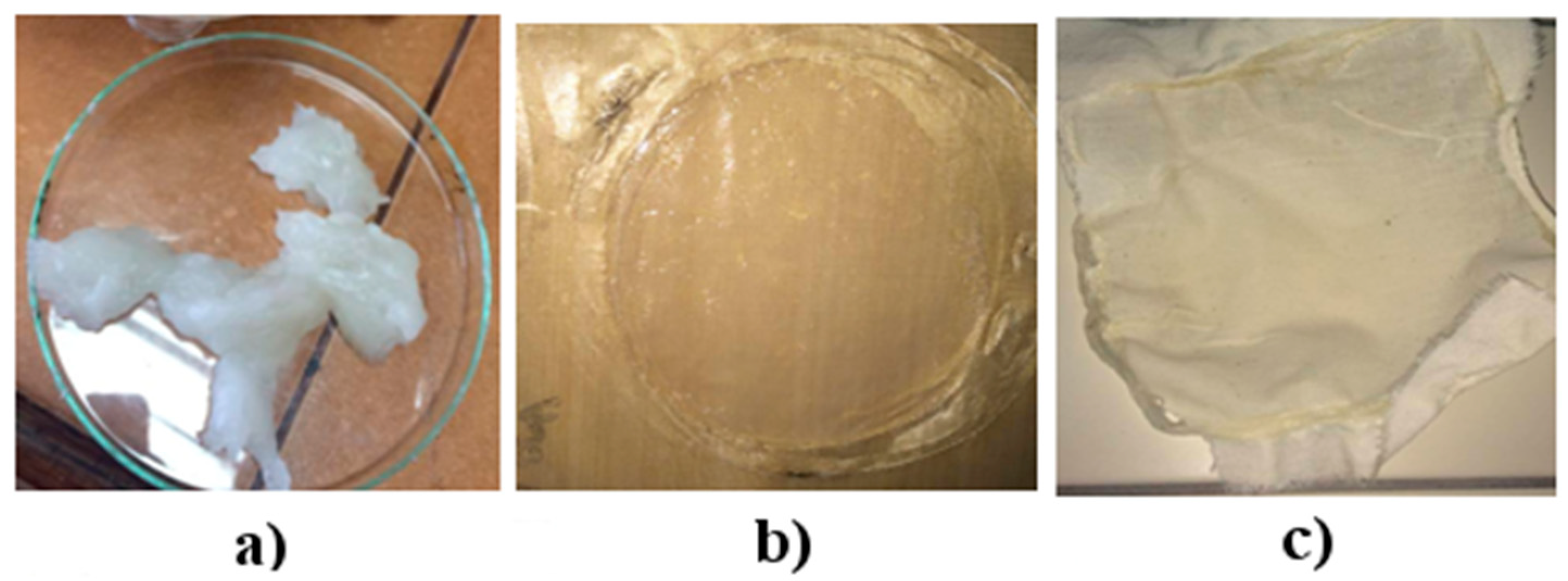
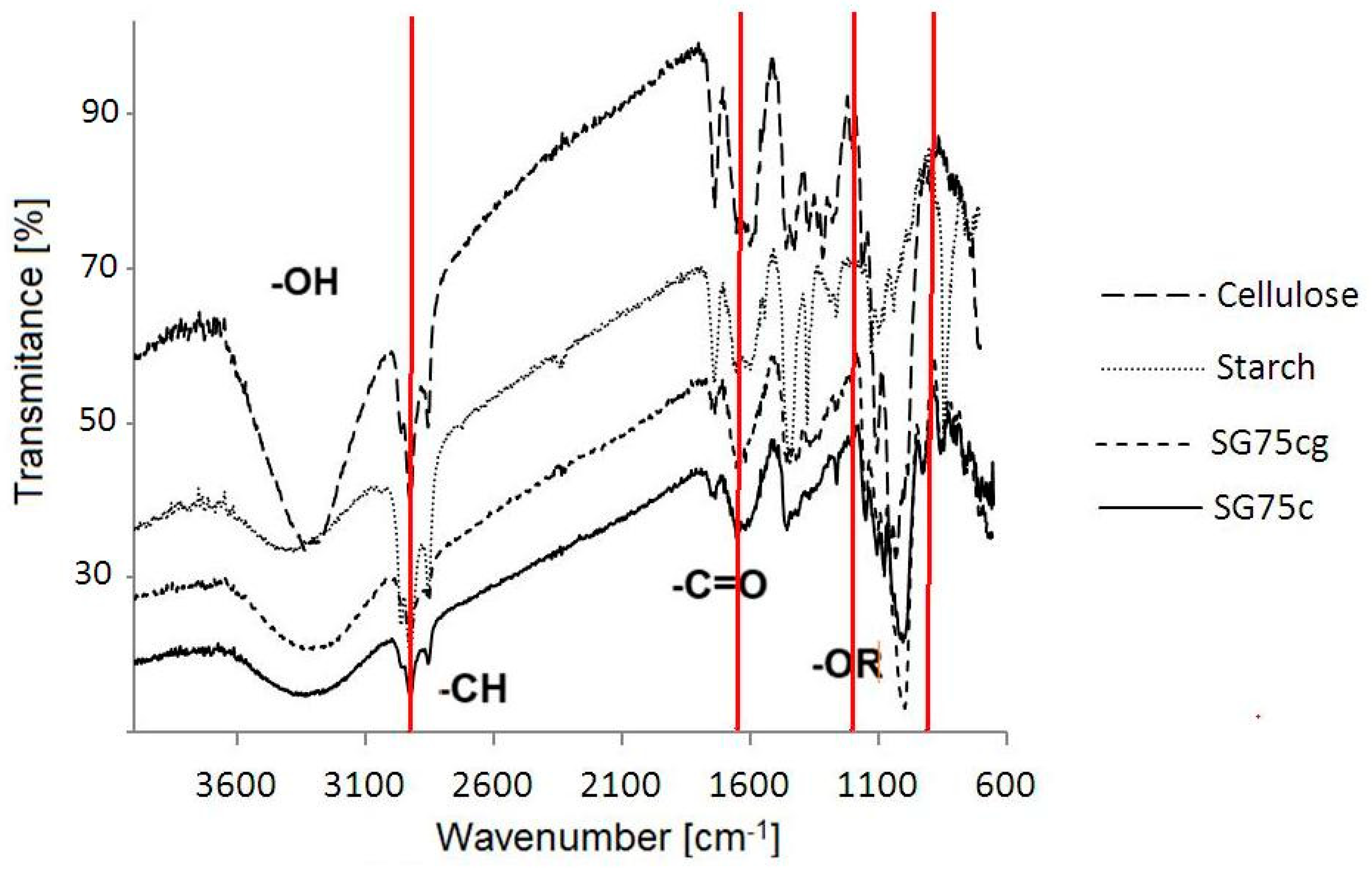
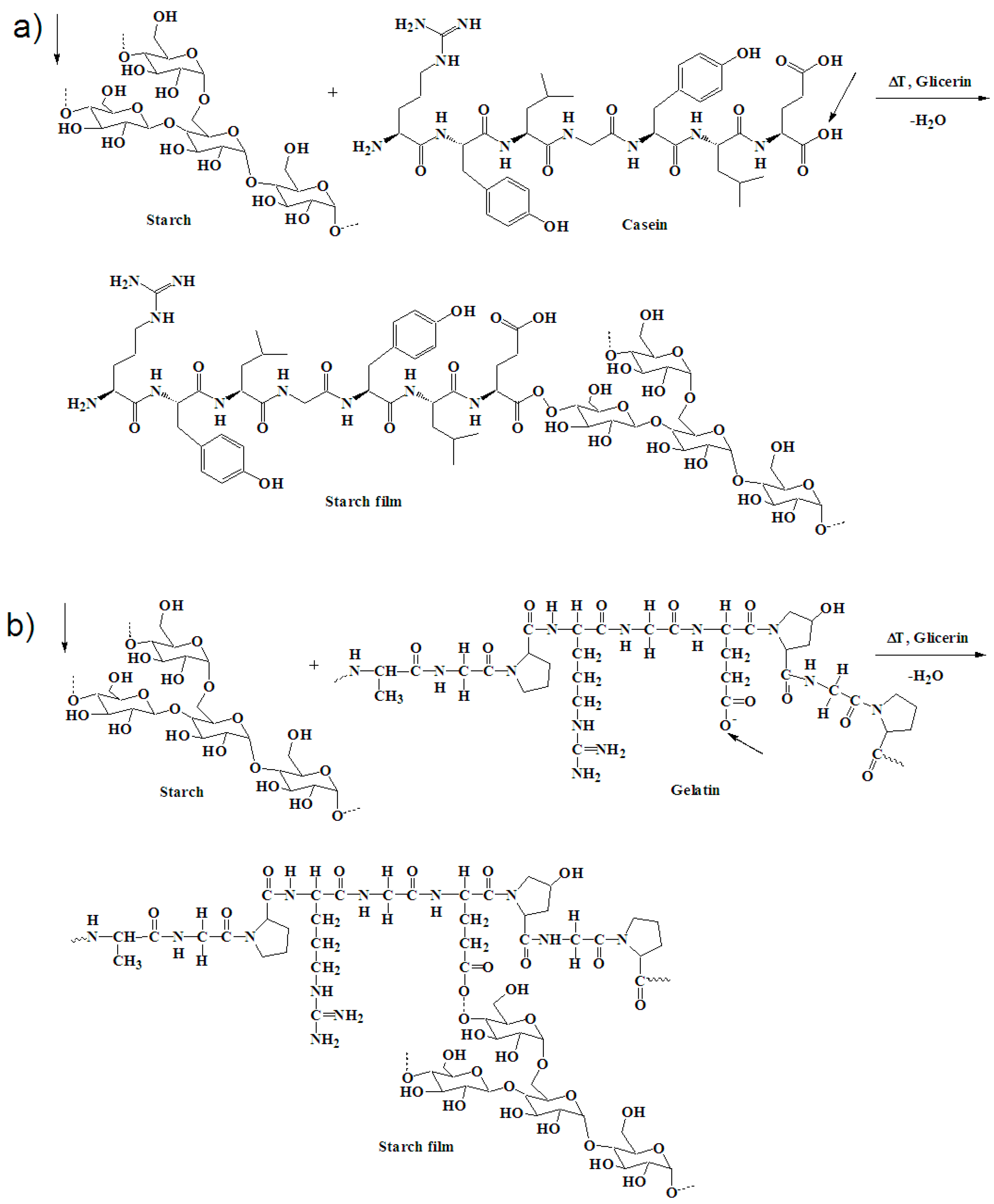

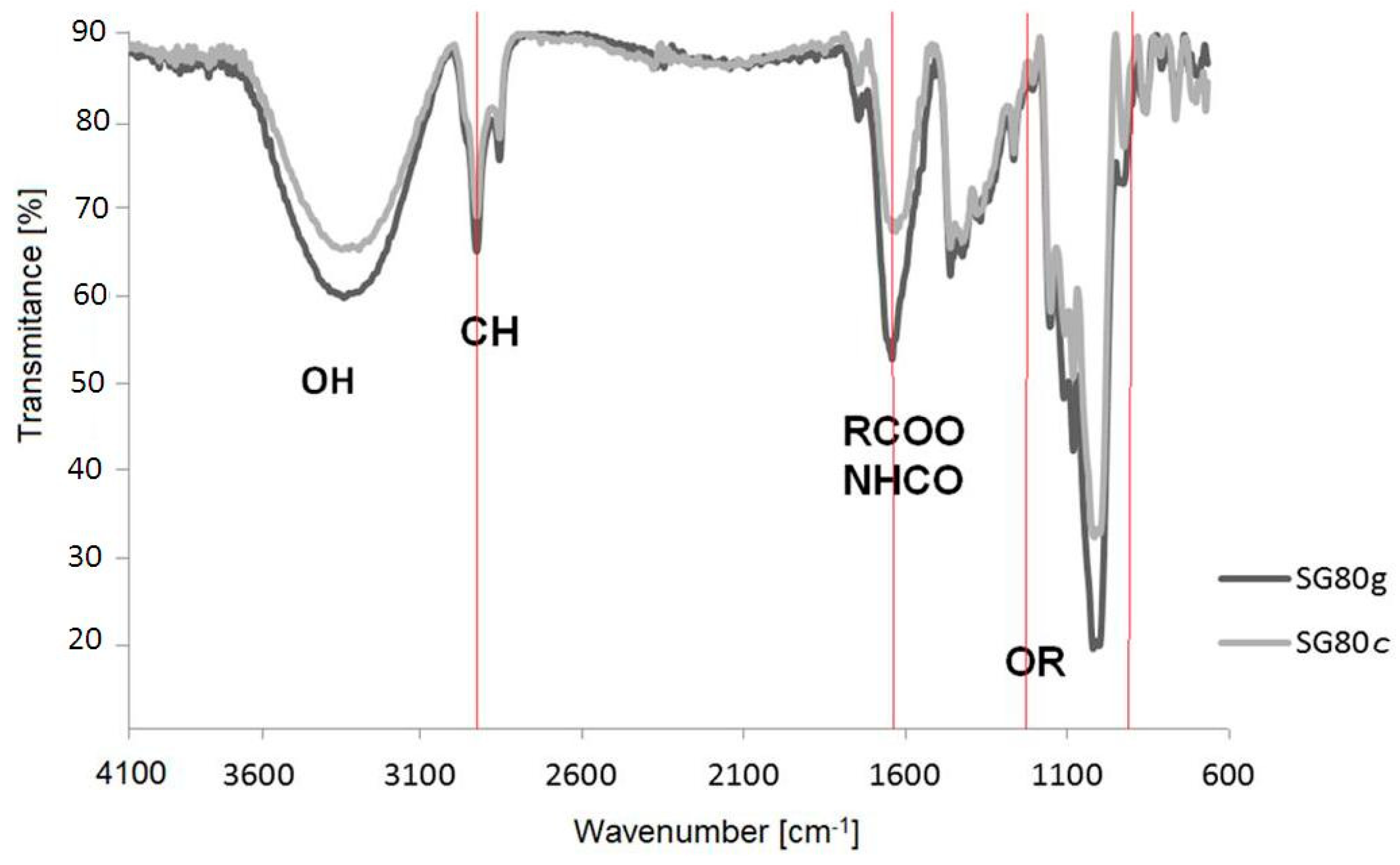
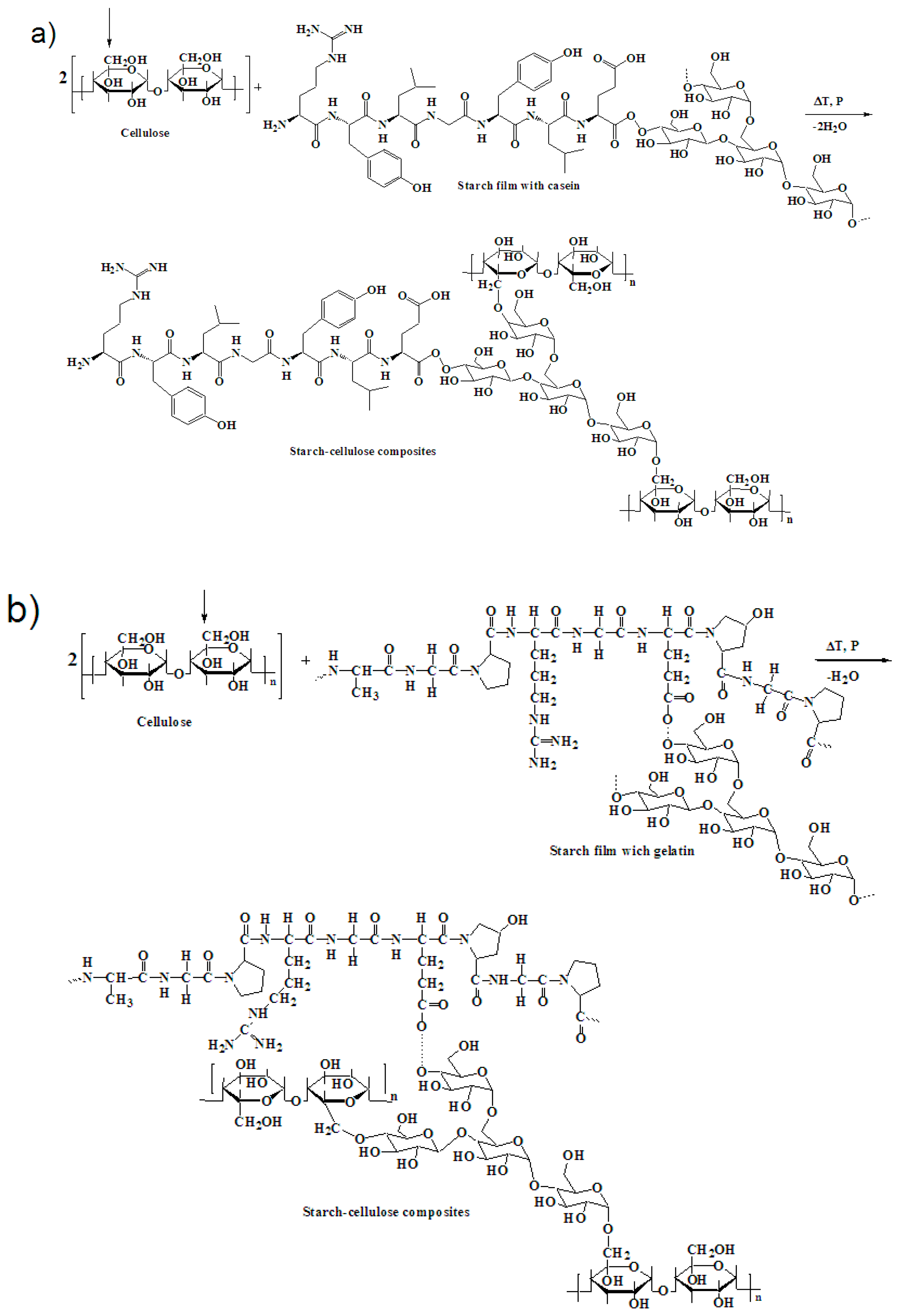
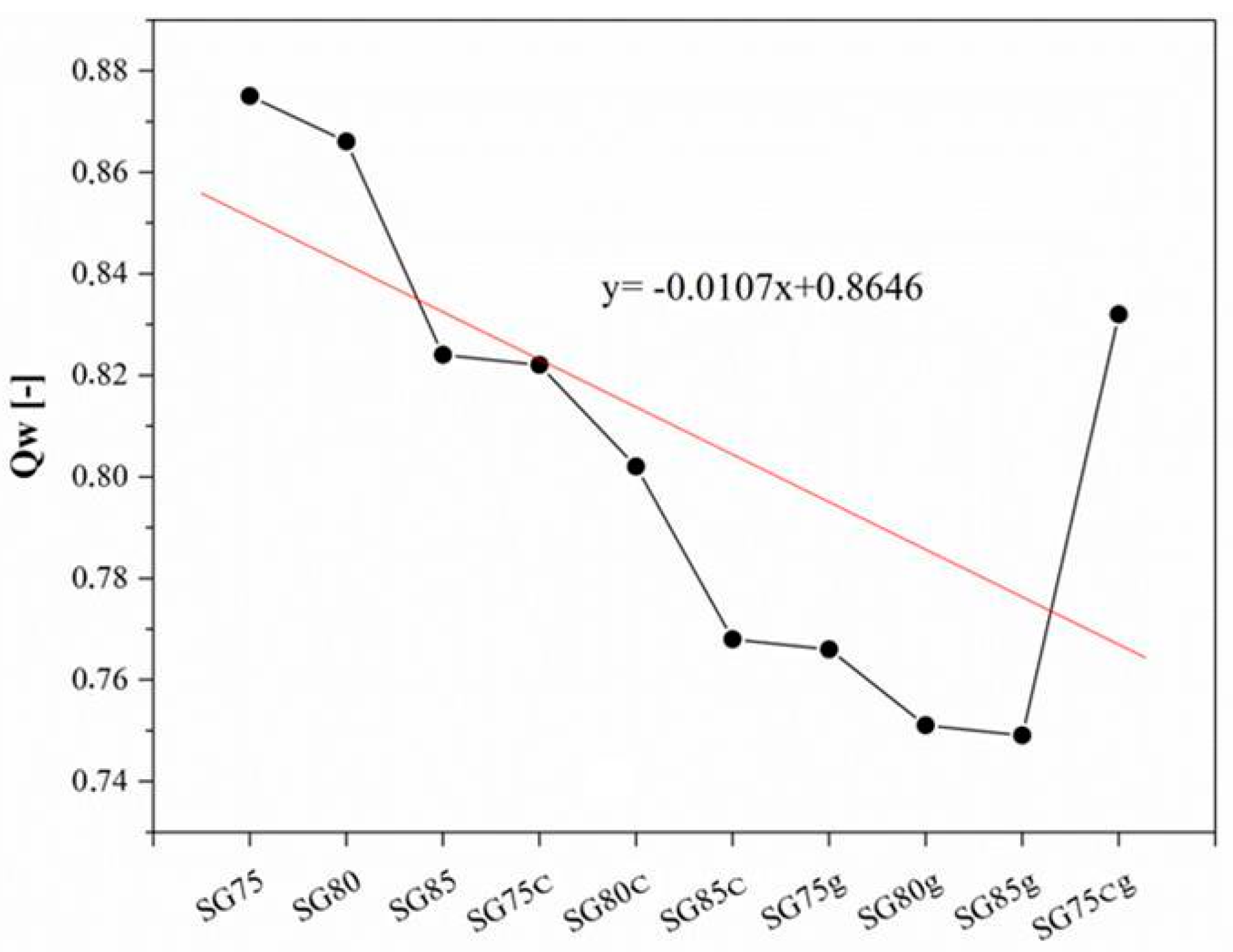
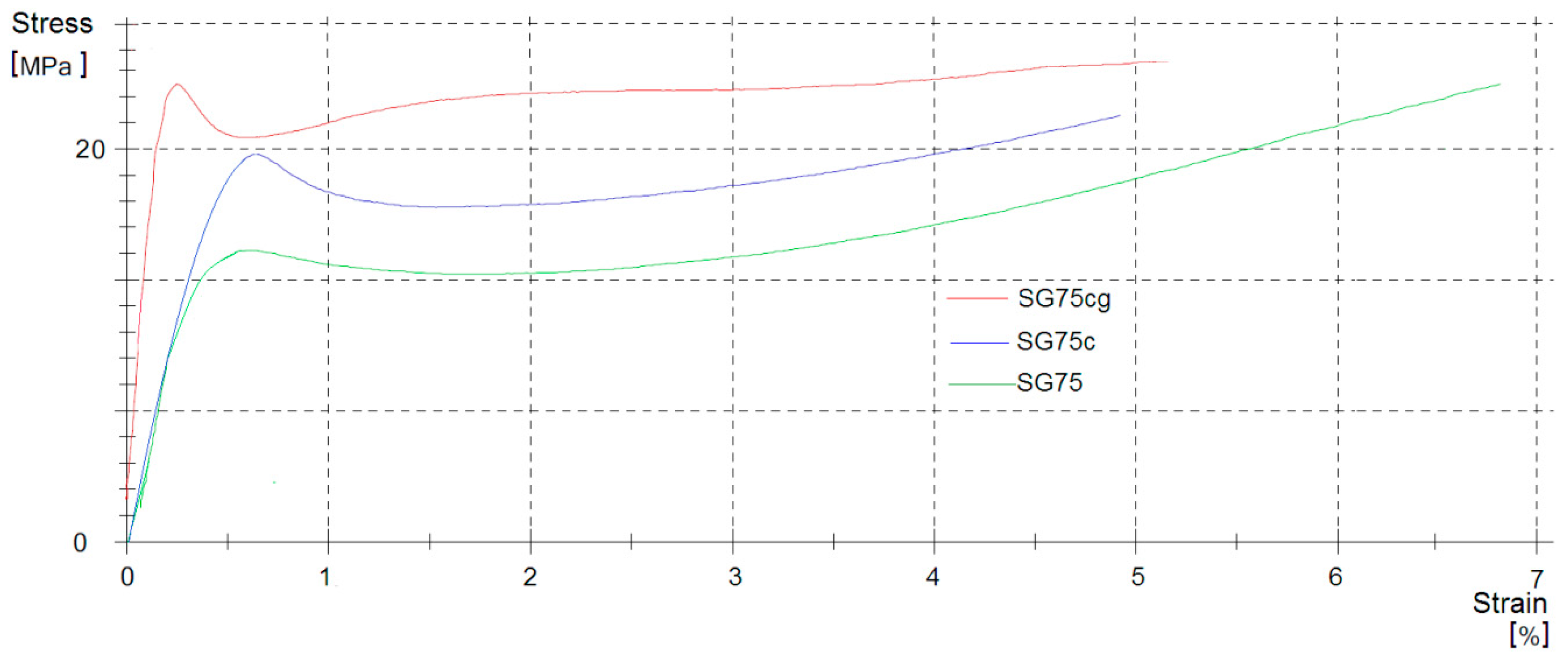
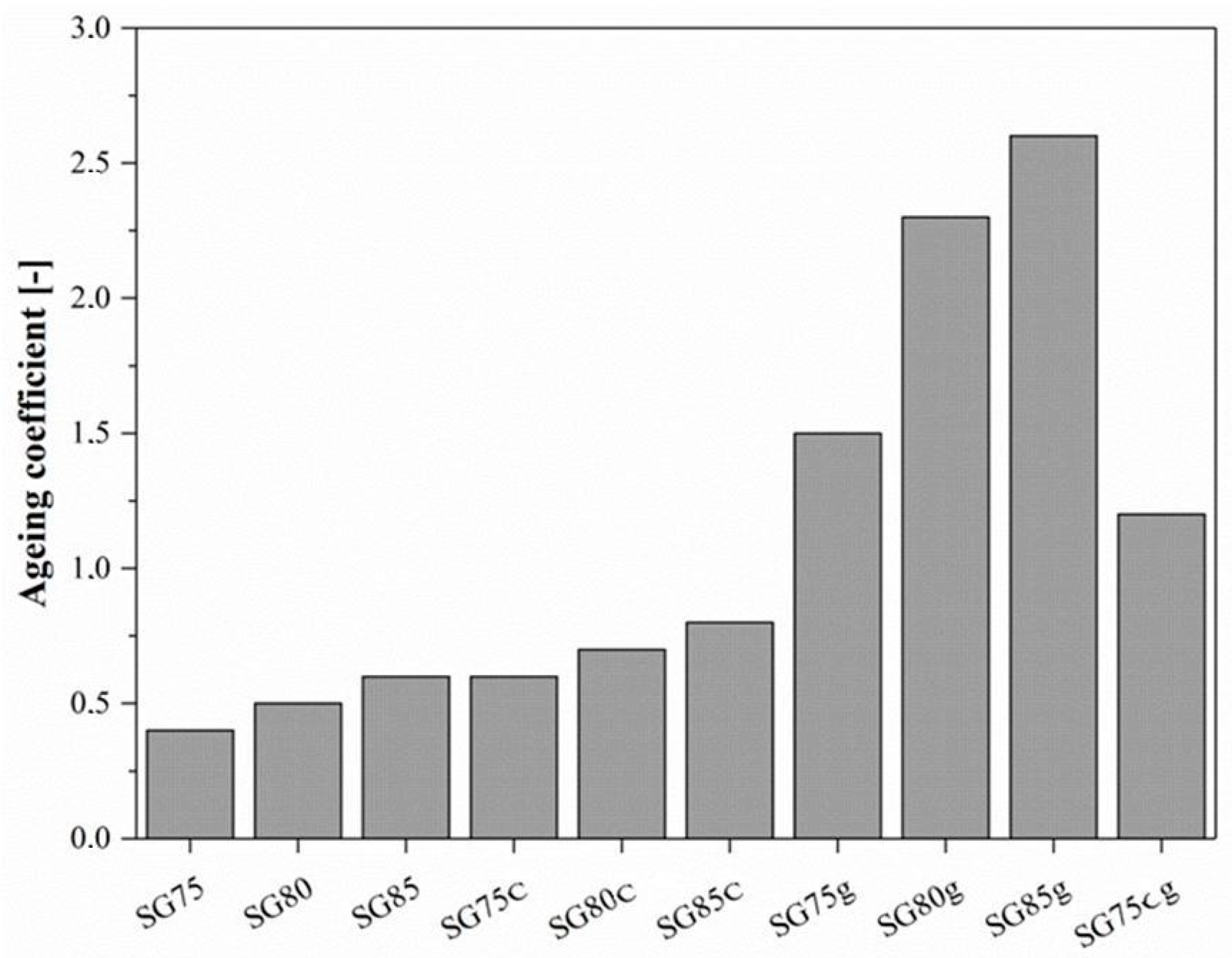
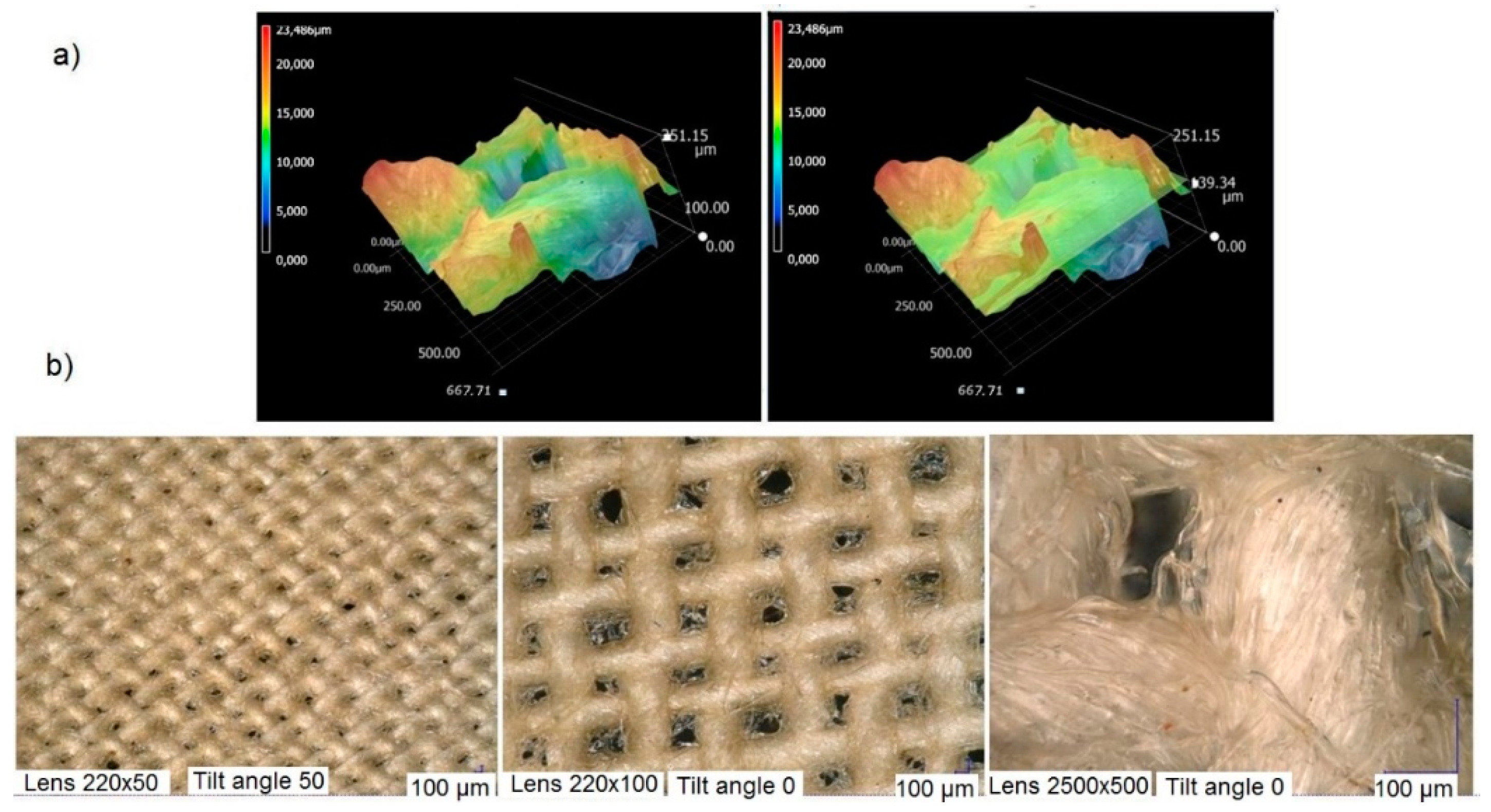
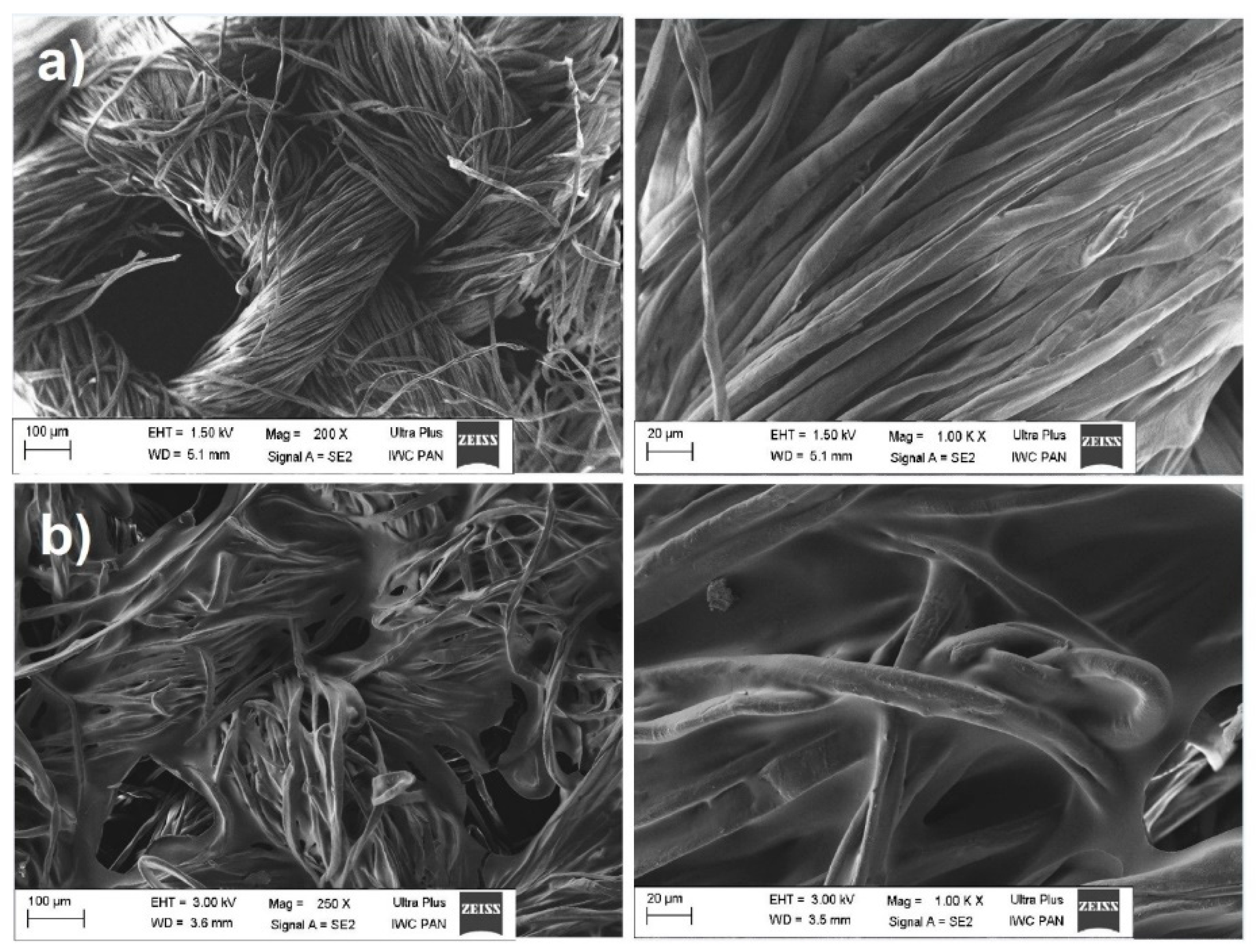
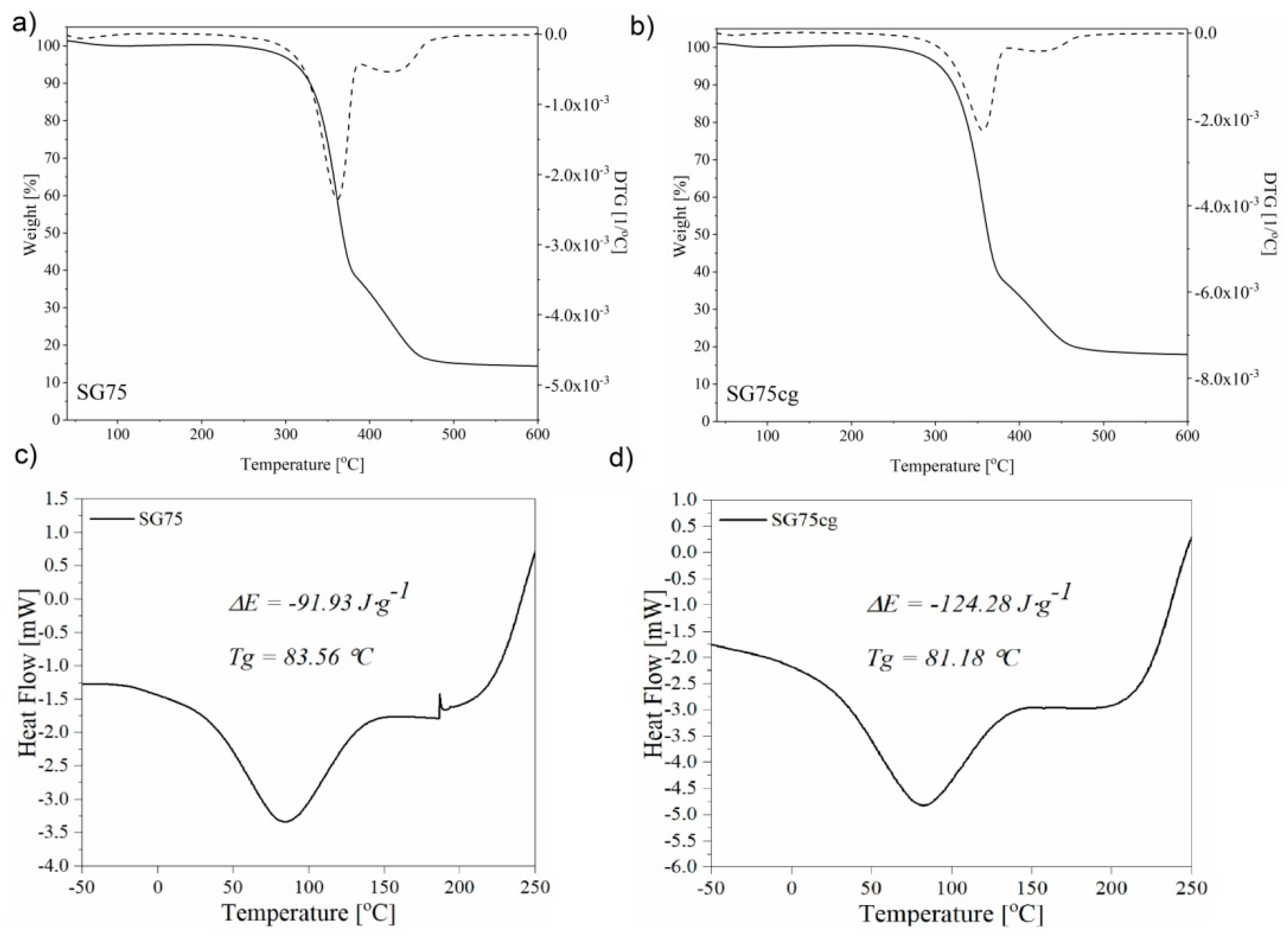
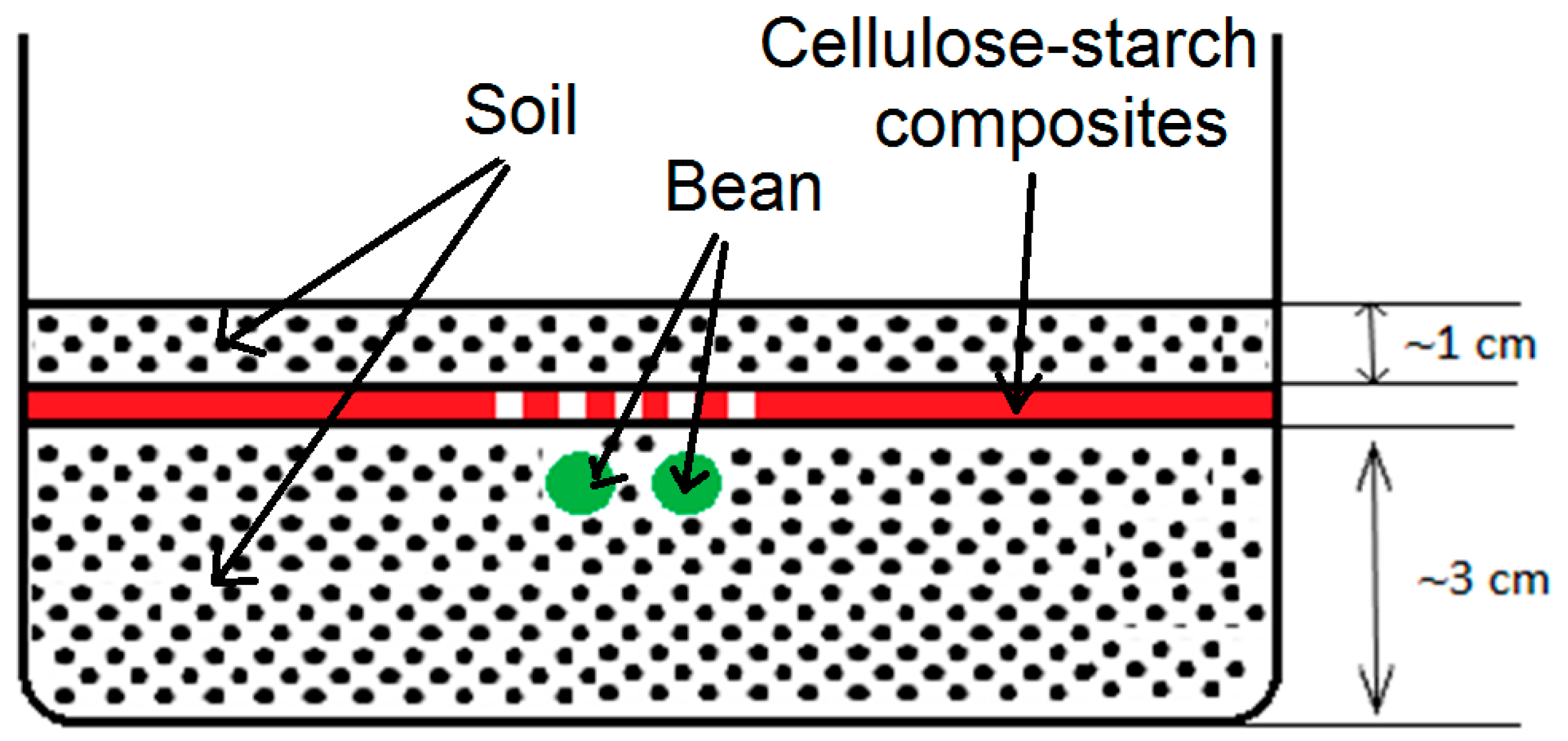
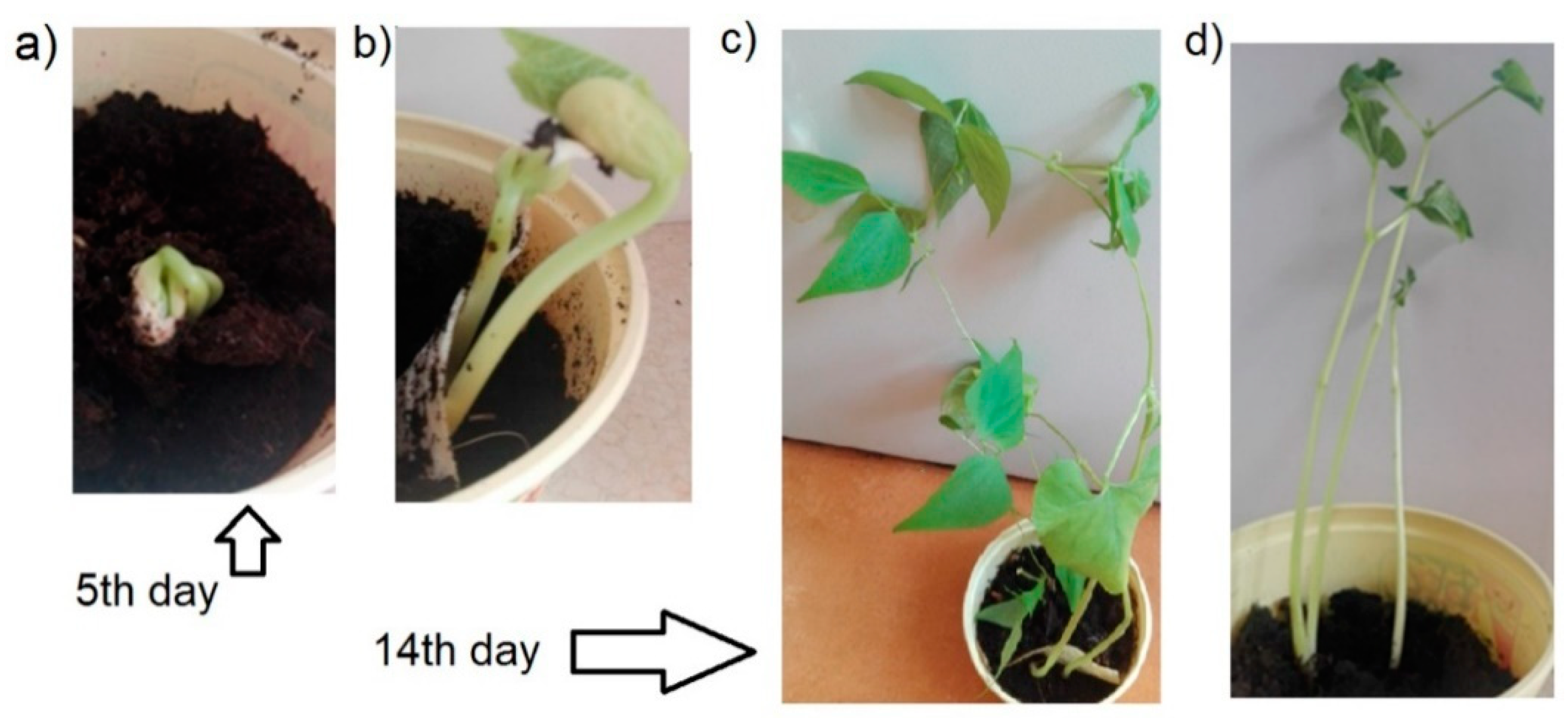
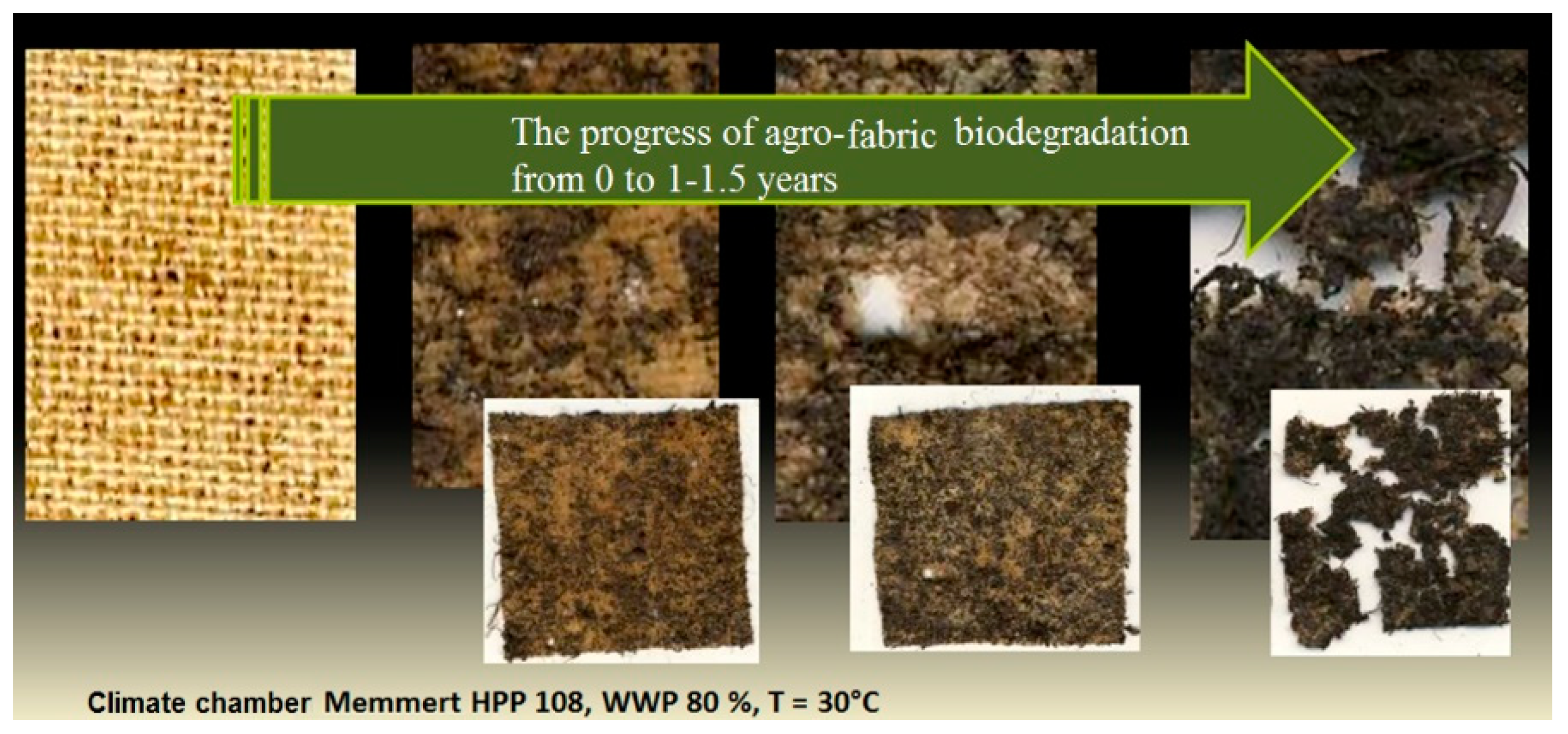
| Component | Quantities of Ingredients (phr) | |||||||||
|---|---|---|---|---|---|---|---|---|---|---|
| SG75 | SG80 | SG85 | SG75c | SG80c | SG85c | SG75g | SG80g | SG85g | SG75cg | |
| Starch (S) | 75 | 80 | 85 | 75 | 80 | 85 | 75 | 80 | 85 | 75 |
| Glycerin (G) | 25 | 20 | 15 | 20 | 15 | 10 | 20 | 15 | 10 | 15 |
| Casein (c) | 0 | 0 | 0 | 5 | 5 | 5 | 0 | 0 | 0 | 5 |
| Gelatin (g) | 0 | 0 | 0 | 0 | 0 | 0 | 5 | 5 | 5 | 5 |
| Compound | Hardness [oSh] | ∆ Hardness [%] | Qw [-] | dE*ab [-] |
|---|---|---|---|---|
| SG75 | 49.0 ± 0.5 | 8.98 ± 0.11 | 1.38 ± 0.02 | 2.59 ± 0.02 |
| SG80 | 55.8 ± 0.1 | 5.87 ± 0.23 | 1.28 ± 0.04 | 1.59 ± 0.03 |
| SG85 | 77.6 ± 0.3 | 5.80 ± 0.06 | 1.37 ± 0.05 | 2.84 ± 0.05 |
| SG75g | 65.9 ± 0.7 | 8.63 ± 0.08 | 1.51 ± 0.01 | 2.27 ± 0.04 |
| SG80g | 62.1 ± 0.4 | 6.67 ± 0.10 | 1.41 ± 0.01 | 2.33 ± 0.04 |
| SG85g | 60.3 ± 0.3 | 7.02 ± 0.08 | 1.34 ± 0.02 | 1.55 ± 0.02 |
| SG75c | 65.9 ± 0.7 | 8.96 ± 0.08 | 1.40 ± 0.02 | 3.77 ± 0.05 |
| SG80c | 77.2 ± 0.8 | 11.31 ± 0.08 | 1.27 ± 0.06 | 2.39 ± 0.03 |
| SG85c | 78.2 ± 0.4 | 9.68 ± 0.08 | 1.28 ± 0.02 | 1.68 ± 0.02 |
| SG75cg | 54.8 ± 0.3 | 6.02 ± 0.09 | 1.42 ± 0.01 | 3.22 ± 0.02 |
| COMPOSITE | Tensile Strength (MPa) | Elongation at Break (%) | Hardness (°Sh) | |
|---|---|---|---|---|
| SG75 |  | 20.1 ± 1.3 | 6.8 ± 0.1 | 49.6 ± 0.3 |
| SG80 |  | 22.2 ± 1.1 | 6.5 ± 0.2 | 51.2 ± 0.3 |
| SG85 |  | 24.2 ± 1.5 | 6.3 ± 0.1 | 52.7 ± 0.3 |
| SG75c |  | 23.3 ± 1.3 | 4.8 ± 0.3 | 70.5 ± 0.3 |
| SG80c |  | 25.9 ± 1.4 | 4.7 ± 0.3 | 76.7 ± 0.3 |
| SG85c |  | 28.3 ± 1.7 | 4.4 ± 0.3 | 78.6 ± 0.3 |
| SG75g |  | 23.6 ± 1.2 | 6.3 ± 0.3 | 59.1 ± 0.3 |
| SG80g |  | 32.1 ± 1.8 | 6.1 ± 0.3 | 62.1 ± 0.3 |
| SG85g |  | 33.2 ± 1.7 | 5.9 ± 0.3 | 64.3 ± 0.3 |
| SG75Cg |  | 25.5 ± 1.3 | 5.9 ± 0.3 | 65.4 ± 0.3 |
© 2019 by the authors. Licensee MDPI, Basel, Switzerland. This article is an open access article distributed under the terms and conditions of the Creative Commons Attribution (CC BY) license (http://creativecommons.org/licenses/by/4.0/).
Share and Cite
Prochoń, M.; Marzec, A.; Szadkowski, B. Preparation and Characterization of New Environmentally Friendly Starch-Cellulose Materials Modified with Casein or Gelatin for Agricultural Applications. Materials 2019, 12, 1684. https://doi.org/10.3390/ma12101684
Prochoń M, Marzec A, Szadkowski B. Preparation and Characterization of New Environmentally Friendly Starch-Cellulose Materials Modified with Casein or Gelatin for Agricultural Applications. Materials. 2019; 12(10):1684. https://doi.org/10.3390/ma12101684
Chicago/Turabian StyleProchoń, Mirosława, Anna Marzec, and Bolesław Szadkowski. 2019. "Preparation and Characterization of New Environmentally Friendly Starch-Cellulose Materials Modified with Casein or Gelatin for Agricultural Applications" Materials 12, no. 10: 1684. https://doi.org/10.3390/ma12101684
APA StyleProchoń, M., Marzec, A., & Szadkowski, B. (2019). Preparation and Characterization of New Environmentally Friendly Starch-Cellulose Materials Modified with Casein or Gelatin for Agricultural Applications. Materials, 12(10), 1684. https://doi.org/10.3390/ma12101684





